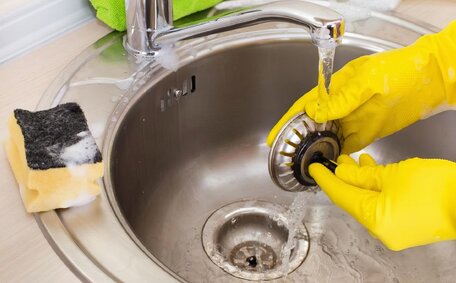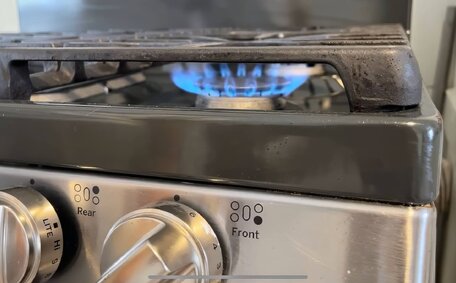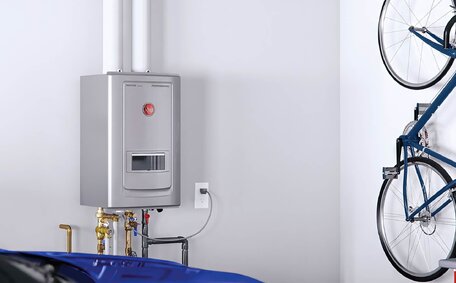Understanding Why Flushing is Important for Hot Water Systems
Flushing your water heater regularly is essential for maintenance. Over time, sediment and minerals accumulate in your hot water tank, making it necessary to perform a flush. Unchecked sediment can impair your system’s efficiency and necessitate flushing.
Regular flushing removes sediment, prolonging your tank’s lifespan and increasing its operational efficiency. Periodic drainage of your water heater ensures debris is expelled, preventing accumulation.
Ignoring the quick task of flushing can result in expensive inefficiencies from sediment accumulation. Make sure to take the time to flush on a regular basis, to keep your tankless water system working efficiently for years to come.
Recognizing When Flushing is Needed
Several signs suggest your water heater requires flushing:
- Discoloured or noisy water coming out of your taps
- Reduced pressure in your hot tap water
- The hot water taking longer to get hot
- Sediment visible when draining the tank
Experts recommend flushing hot water systems annually to prevent issues. Understanding flush techniques for local water hardness is crucial for effective maintenance.
Noticing these warning signs usually indicates overdue sediment buildup, signalling a need to learn how to flush your system. Catching buildup early prevents your system from eventual back up.
Should you have queries like 'Do I flush my gas water heater the same way as electric?' or notice severe sediment buildup, reach out to a licenced plumber. They can assess when your system needs flushing and help perform maintenance safely.
Gathering the Necessary Equipment and Parts
To flush your home’s hot water system, you’ll need to gather some key equipment beforehand:
- Garden hose - A garden hose long enough to reach from the drain valve to a drainage area is required.
- Bucket - Have a bucket on hand to catch initial water flow when opening valves.
- Adjustable wrench - An adjustable wrench allows you to loosen and tighten valves.
- Safety goggles & gloves - Wear goggles and gloves as safety measures before draining hot water.
Before commencing, turn off your hot water system’s power at the circuit breaker. And it’s wise to consult your owner’s manual to figure out how to flush your hot water system, ensuring you turn off the correct valves or systems.
Once you’ve prepared this basic safety equipment and reference material, you’re poised to begin draining and refreshing the water in your hot water heater.
Safely Turning Off the Water Heater
Safety dictates shutting off the water heater before starting the flush to safely expel water from the system. Carefully turning off the heater prior to flushing helps prevent scalding and pressure buildup. Here are the steps:
- Begin the flushing process by locating and turning off the power switch or circuit breaker for your unit, and shutting off the cold water supply as well. Mind you, this advice pertains to how flush your electric water heater units and differs slightly for gas hot water heaters.
- For gas water heaters, proceed to turn off the gas at the designated valve. For a gas hot water heater, note that the pilot light extinguishes once the gas supply ceases.
- Turn hot water valve on the top of the tank to a closed position. Use an adjustable wrench to fully close the cold water valve.
- Connect a garden hose to serve as a hose drain to the drainage valve located near the bottom of the tank. Ensure the end hose runs safely to a designated drainage area.
- Place a bucket beneath and ensure the valve off before starting to release water. Gently open the valve and begin to drain your water from the heater’s contents into the bucket.
- As the water temperature drops, fully open the valve to begin the process to drain the hot water from the tank. Let the out drain action proceed until it is completely empty.
Working with the electrical or gas components of a hot water system can be dangerous. If you have any uncertainty about safely handling your system, seek assistance from a licensed plumber.
Disconnecting and Draining the Water Supply
To flush your water heater tank system, ensure proper disconnection and arrange for complete drainage. Here are the key steps:
- Ensure you switch off the power and also turn off the cold water supply at the tank before proceeding. These precautions are part of learning how to flush hot water systems and safeguard against accidental encounters with the heating element.
- Close the cold water valve to prevent the tank from refilling during maintenance. Utilise a wrench to seal the valve all way shut, verifying no water sneaks into the tank during maintenance.
- Attach a garden hose to the drain at the bottom of your hot water unit, directing the other end to a safe drainage area.
- Place a bucket under the drain valve, allowing hot water to cool down as it catches the initial flow when opened.
- Carefully crack the drain valve open, thus allowing water to start flowing into the bucket, paving the way for a cooling phase.
- Once cooled, fully open the drain valve to commence the drain tank operation, emptying the water heater.
- Let the process of draining your hot water continue, monitoring the flow until water runs clear.
With the power off and water supply closed, the system is now safe to disconnect and flush your hot water unit. Flushing can remove accumulated sediment, allowing fresh water to refill the tank after maintenance.
Attaching and Opening the Drain Valve
A crucial step in flushing your hot water system is to correctly attach a garden hose to the drain valve. This ensures water can be safely directed away for drainage. Follow these steps:
- Locate the drain valve at the bottom tank area. It typically looks like an outdoor hose bib or spigot.
- Clear the space around the valve, confirming it is securely closed before you turn back to attach the hose. Use an adjustable wrench to turn it clockwise.
- Securely connect a garden hose and turn the drain valve spigot. Tighten by hand and then give an extra quarter turn with the wrench.
- Position the other end of the hose to drain outside or into a suitable waste area.
- Set a bucket beneath to capture the initial surge of water once you twist the ball valve to drain.
- Use a screwdriver to gently turn counterclockwise and then proceed to drain water from the heater. This approach lets you safely open the valve, preparing to expel any sediment.
- Once water runs cool, open the valve completely by hand to flush the tank contents out through the hose.
Improperly opening the pressurised relief valve too quickly can damage your system and lead to safety issues. Always take precautions when beginning tank drainage.
Rinsing Out Sediment Thoroughly
Once the pressure relief valve is fully open, let the water run sufficiently to completely flush the sediment from the hot water system. Ensure the tank drains completely until the water from your system runs clear, free from visible sediment or discoloration.
Position a bucket to catch water initially so you can monitor clarity. If the tap water is still discoloured or contains sediment after 5-10 minutes of draining, pause to let sediment settle before resuming flushing.
You may need to pause and resume the process a few times to thoroughly flush your water heater. During interruptions, give the drain valve one more rapid twist to agitate and release additional sediment, effectively performing a water heater flush. Repeat as needed until all the water you drain your hot water system is completely clear.
Aim to flush the system for a good 15 minutes at minimum, longer if needed. Thorough rinsing removes all traces of mineral deposits or sediment so none remains in the tank or pipes once you’re ready to refill with fresh water.
Reattaching and Turning On Systems
After thoroughly flushing the sediment from the hot water tank and the water runs clear, reattach components to restore system operation. Here are the key steps:
- Tighten all hose connections with an adjustable wrench and inspect for leaks.
- Close the drain valve completely, double check by trying to turn it further clockwise with a wrench.
- Reopen the cold water inlet valve to allow fresh water into system.
- Check around all fittings and valves for any drips or leaks as the tank refills. Tighten if needed.
- Once water starts flowing steadily from the hot water faucet, allow air pockets to purge by letting it run for a few minutes.
- For gas hot water systems, you should turn hot water back on by reigniting the pilot light according to manufacturer instructions.
Take precautions when restoring operation to a hot water system after maintenance. Ensure all connections are tight and fully secure before turning power back on to avoid issues.
If reigniting your heater then becomes a challenge, engaging a professional plumber for swift aid in reactivation and operation verification is advisable.
Signs of Lingering Issues After Flushing
Even a thorough flush may leave issues that reappear. Be vigilant for these lingering signs:
- Sediment or dirty water tap contents coming out shortly after flushing
- New debris accumulating rapidly over the next few weeks
- Reduced water flow or pressure
- Noisy water flow from pipes or taps
- Hot water taking longer to heat up again
Should you observe such signs, it often signals a need for an additional water heater turn maintenance flush to address remaining debris. Further flushing or maintenance may be required.
In particular, pay attention in the first month after flushing. If issues reemerge in this period, contact a professional plumber to inspect your hot water system pipes and fittings thoroughly. Persistent sediment or buildup can sometimes lodge in areas that are difficult to access and flush out through standard tank draining.
A plumber can use specialised tools to purge any lingering debris you may be unable to remove through DIY flushing methods. Catching lingering problems quickly also helps prevent serious blockages or breakdowns.
Knowing When to Engage a Professional Plumber
Seek a professional plumber’s help if you’re uncomfortable flushing your hot water system or encounter issues like sediment buildup. A few scenarios when you may want assistance include:
- Noticing warning signs like sediment or leaks after self-flushing
- Unsure how to safely turn off gas/electric water heater
- Can’t access or disconnect components of the system
- Don’t have the right equipment for drainage
- Water runs cold shortly after flushing
- Have an older or complex hot water setup
For prompt and dependable hot water system flushing and maintenance, reach out to the licensed professionals at Pennant Hills Plumbing. Our expertise covers all hot water system brands, and we can troubleshoot persisting issues.
Our qualified plumbers ensure thorough flushing and can pinpoint causes for ongoing sediment or efficiency problems. We employ contemporary methods and tools to eliminate all debris. Get in touch with us for professional maintenance of your hot water heater at any time.






